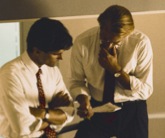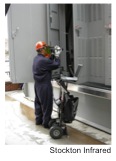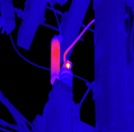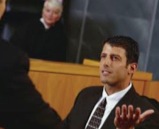Article Archive
Infrared Thermography for Expert Witness and Legal Documentation

R. James Seffrin and Christopher J. Seffrin
Infraspection Institute
425 Ellis Street
Burlington, NJ 08016
Tel. 609-239-4788
Introduction
Over the past two decades, infrared thermography has been used as documentation in criminal as well as civil cases. Courts have accepted thermography as evidence used to prove or disprove claims by opposing parties.
Infrared imaging for legal documentation has been commonly used in civil courts for medical cases involving spinal injuries. In these cases, infrared thermography has been used to document warmer areas of the body associated with injury and pain.
Criminal courts have also seen their share of infrared imaging. Law enforcement investigators have utilized infrared imagery to help obtain search warrants. These cases are not without controversy as some contend that this use of infrared imaging is a violation of individual privacy.
Over the past decade, thermography has been introduced in commercial and industrial civil cases to document failures or to disprove a party’s claim that a particular system or component has failed. Due to its graphic nature, thermography can make for compelling evidence. Before thermographic evidence is presented in a case it must be properly collected and documented. It is then the role of a thermographer to provide testimony in the role of an expert witness so that the documentation can be entered into evidence.
The Expert Witness
Due to their experience and qualifications in some special field, the expert witness is someone whose statements and opinions are accepted in a legal proceeding. Because they possess special skills and knowledge, expert witnesses are usually paid for their time and efforts by the clients for whom they work.

While television and films tend to dramatize the role of experts, the truth is that expert witnessing is often far less glamorous. The expert’s role is to document conditions that he observed and subsequently present these findings along with his opinions and interpretations in legal settings.
A talented expert must be multifaceted: he must be well-trained, he must be a competent investigator, he must be able to document his findings in a logical and concise report, and he must be able to intelligently present his findings during legal proceedings. A true professional must also be ethical. He must be able to honestly assess his capabilities and always work within his limits. A professional expert must seek to maintain his training and to keep himself informed as to the latest developments within his technology.
In most cases, thermographers who seek work as expert witnesses will be required to perform or supervise the infrared inspection as well as provide any subsequent testimony. In those cases, the client or his attorney will usually retain the thermographer prior to the start of the project.
Occasionally, a thermographer may be retained as an expert to review another thermographer’s work or documentation. He may be called as a witness to help rebut another thermographer’s testimony or report.
Additionally, a thermographer may be subpoenaed to testify about his previous work or reports without advance notice. Although the thermographer may not seek to work as an expert witness, he may still be considered an expert by the court if he performed the work in question. Regardless of how a thermographer is invited to the court, the experience can be more tolerable if some basic guidelines are followed.
Reviewing the Case
Usually, an attorney or other professional initiates the request for a thermographer to participate in a case. Prior to taking a case, it is important to understand what the client is trying to determine and what is expected from the results. Due to limitations of thermography or the thermographer, sometimes it is not possible to provide the information a client is looking for. At other times, it may not be possible to deliver data within a requested time frame. In such cases an expert should advise why the requested information cannot  be delivered and discuss alternatives with the client. In some cases, it may be necessary to decline the case or refer the case to someone else.
be delivered and discuss alternatives with the client. In some cases, it may be necessary to decline the case or refer the case to someone else.
Once it has been established that the request is reasonable and that the case is within the realm of the expert’s area of competence and capabilities, plans can be made to proceed. The expert should discuss the work with the client and develop a clear scope of work to be followed. He should also discuss the type of documentation required and a time frame for completion. It is also incumbent upon the thermographer to advise the client that the anticipated results may not support the case.
Proposal and Fees
A written proposal should be forwarded to the client clearly outlining a fee schedule for the initial work as well as a fee schedule for any subsequent testimony should it be necessary. Many experts will only work on a retainer basis. This ensures that the expert is compensated whether or not the results support the client’s case.
Some experts require full payment in advance while others require a percentage upon acceptance with balance due upon delivery of report. It is recommended that all fees be paid prior to any testimony. This helps to ensure the expert’s integrity since he does not have a financial stake in the outcome of the case.
Performing the Work
Once a scope of work has been defined and accepted by the client, it should be strictly adhered to. Following currently accepted Standards, Specifications or Guidelines reduces the burden upon the thermographer since he is following accepted industry practices. In short, there is greater safety in numbers.
 Work should be performed by qualified personnel. Work should only be performed when weather and environmental conditions are favorable to collecting accurate data. Only test equipment suited for the inspection should be utilized. Equipment must have the proper spectral response, optics, filters, and accuracy required to perform the job properly. All equipment should be in good working order and within calibration as recommended by industry standards or manufacturer’s recommendations. Any calibration documentation should be maintained with the job records.
Work should be performed by qualified personnel. Work should only be performed when weather and environmental conditions are favorable to collecting accurate data. Only test equipment suited for the inspection should be utilized. Equipment must have the proper spectral response, optics, filters, and accuracy required to perform the job properly. All equipment should be in good working order and within calibration as recommended by industry standards or manufacturer’s recommendations. Any calibration documentation should be maintained with the job records.
Stockton Infrared The results of any verification of infrared data, such as ammeter readings or roof core samples, should be included in the written report. Equipment used for verification should also be in good working order and within calibration. If others provide verification, the thermographer should witness or oversee the verification procedures.
Thermographers must be aware that artificial conditions such as using a blower door or working under extreme weather conditions can compromise the credibility of their work as evidence. Work performed under these conditions may cause the rejection of the report as evidence. Thermographers who use software to enhance infrared images also run the risk of having their work rejected by the court since it has been artificially manipulated.
Documentation of Results
Documentation is critical both during and after the infrared inspection. During the infrared inspection the thermographer should note the name and address of the company performing the inspection as well as the thermographer and any qualified assistants or witnesses. The manufacturer, model, and serial numbers of all test equipment should also be recorded. Lenses, windows, and filters should be documented along with their spectral responses and transmission values.
Weather and significant environmental conditions should also be documented. These include wind speed and direction as well as sky conditions. For  moisture sensitive work, the latest date of precipitation should also be noted. The condition of the system being inspected should be noted as well. Ambient temperature, system load, emissivity, distance to target, and background radiation values should be measured and recorded.
moisture sensitive work, the latest date of precipitation should also be noted. The condition of the system being inspected should be noted as well. Ambient temperature, system load, emissivity, distance to target, and background radiation values should be measured and recorded.
Finally, the thermographer should document the observed thermal patterns on thermograms and/or video records. The final report forwarded to client should be clear and concise and contain as much of the previous data that is applicable to the project at hand. It should also contain all the documentation required by the standard or specifications that you are working under. The thermographer’s final report should also include his opinions based upon his findings.
When preparing a report that is intended for use in a legal case, it may be a good idea to forward a draft report to your client or his attorney. This will help to avoid contradictions between experts and helps to ensure that your report properly supports the case. Above all, a thermographer’s report should be confined strictly to his area of expertise and responsibility within the case.
Deposition, Trials & Arbitration
Once a written report has been submitted, there are two avenues of progress. If the report does not support the client’s case, the thermographer will likely play no further role in the case. If the thermographer’s report does support the case, the case will likely proceed to a deposition.
A deposition is usually made outside the courtroom in a less formal setting such as an attorney’s office. During the deposition a witness provides testimony under oath which is recorded and used when the case comes to trial. Questions here can be more open- ended and the witness must be careful with his testimony since it can be used against him in a trial.
Arbitration is a proceeding before an arbitrator or panel of arbitrators intended to help settle disputes rather than proceeding to a trial. Although arbitration is less formal than a courtroom setting, it is every bit as serious as the expert provides testimony under oath just as in a courtroom setting. Should arbitration be unsuccessful, the expert may have to appear again at trial. Once again, an expert’s previous testimony can be used.
Trials are conducted by a formal examination of the facts of a case by a court of law to decide the validity of a charge or claim. A trial is the most formal of settings and again the witness is under oath. Again, the expert’s previous testimony may be used. It is imperative that an expert always be aware of his previous testimony in the case as well as his work.
Prior to making an appearance, it is recommended that the expert meet with his client’s attorney to discuss potential questions and relevant facts of the case.
Up to this point, we have discussed the course of action for experts who are appearing willingly in the court. At times, a thermographer might be subpoenaed without warning. There are few things more uncomfortable than having a report introduced that contains inadequate documentation. Experts who have been subpoenaed can only be compelled to state the facts relevant to their report. They are not required to provide opinions about their work.
Delivering Testimony
 Experts who properly execute their work and document their findings will have a far easier time when it comes to testifying. Prior to testifying, the expert should prepare a curriculum vitae which summarizes his training, qualifications and work experience. This will be introduced as part of the court record during examination of the witness. If you are testifying for the first time, it may be helpful to review the types of questions that you might be asked under oath with your attorney. Some general rules are as follows:
Experts who properly execute their work and document their findings will have a far easier time when it comes to testifying. Prior to testifying, the expert should prepare a curriculum vitae which summarizes his training, qualifications and work experience. This will be introduced as part of the court record during examination of the witness. If you are testifying for the first time, it may be helpful to review the types of questions that you might be asked under oath with your attorney. Some general rules are as follows:
1. Stick to your area of expertise! Do not volunteer or express opinions for which you have not been tasked to investigate.
2. Be prepared and know your information before you come to court. This includes reviewing your report videotapes, field notes and any pertinent depositions.
3. Never answer a question that you do not understand. Always ask for clarification when you don’t understand.
4. Never disclose what your attorney has discussed with you.
5. When asked a question, take at least 15 seconds to make sure you understood the question. Try to anticipate where a line of questioning is headed.
6. Beware the compound question. Often lawyers will ask a series of questions together in order to disorient the expert. When this happens, ask that the question be restated as several smaller questions.
7. Be on guard. Opposing counselors are paid to be good opponents. Do not allow yourself to become complacent during testimony.
8. Any documents or notes that you bring to court or make during a proceeding are discoverable.
9. Do not try to be humorous.
10. Speak slowly and clearly. Use a well-modulated voice.
11. Do not read prepared narratives as they can make the expert appear that he does not know his craft.
12. Do not fidget or use hand gestures. Use good posture.
13. Be polite and courteous. Never raise your voice or appear argumentative.
14. Dress appropriately and be on time!
15. If you have been subpoenaed, you are not required to offer an opinion.
16. When appropriate, do not answer questions with yes or no answers. Rather, elaborate to the extent necessary to answer the question properly.
17. Never state that a published work or test is correct or factual. The appropriate response is I’ve read it or I know of it.
18. If your attorney objects to a question, keep silent until the objection is ruled upon and you have received an instruction on whether to answer.
19. Be true to your ethics. Do not accept cases where your testimony would contradict previous testimony in other cases. Never take a case where you have a conflict of interest.
20. When presenting charts, graphs, maps or videotapes, the witness should speak clearly and slowly and elaborate exactly what he is describing. Videotapes in particular cannot be incorporated into a transcript.
Summary
Due to its graphic nature, thermography makes for compelling evidence. Because it is often used to document failures of systems or structures, thermography can often wind up as evidence in legal cases. Thermographers can better serve their clients and avoid potentially embarrassing situations by keeping their training current, working within published standards, and properly documenting their findings. Facing an unexpected subpoena is less unpleasant if thermographers always endeavor to work within industry standards and document their work thoroughly.
For those who seek a challenge, expert witness work can provide a whole new area of business and professional opportunities.
References
1. The Expert Witness. Peter B. Dorram. Copyright 1982 by the American Planning Association, Chicago, IL.
Advertisement

